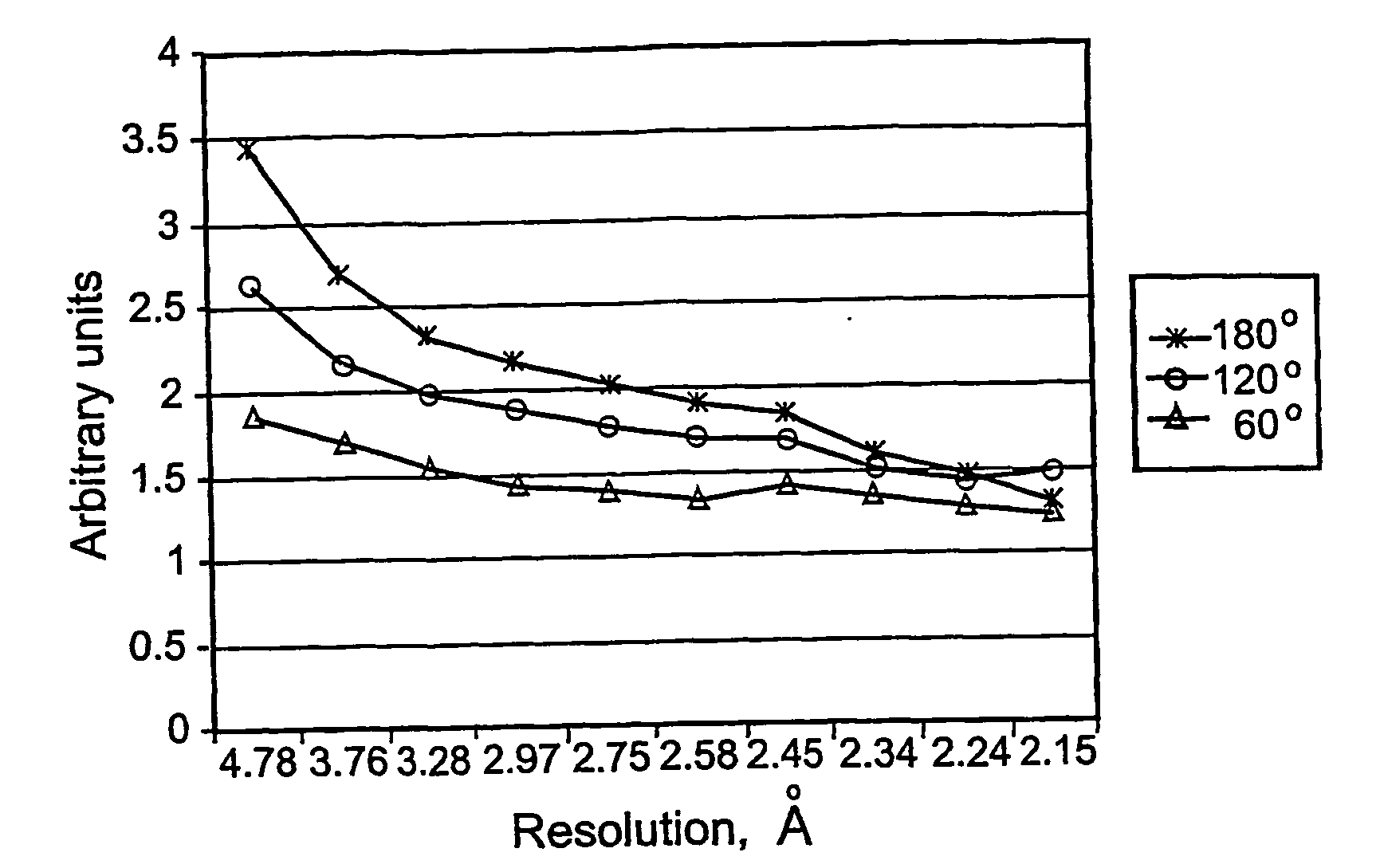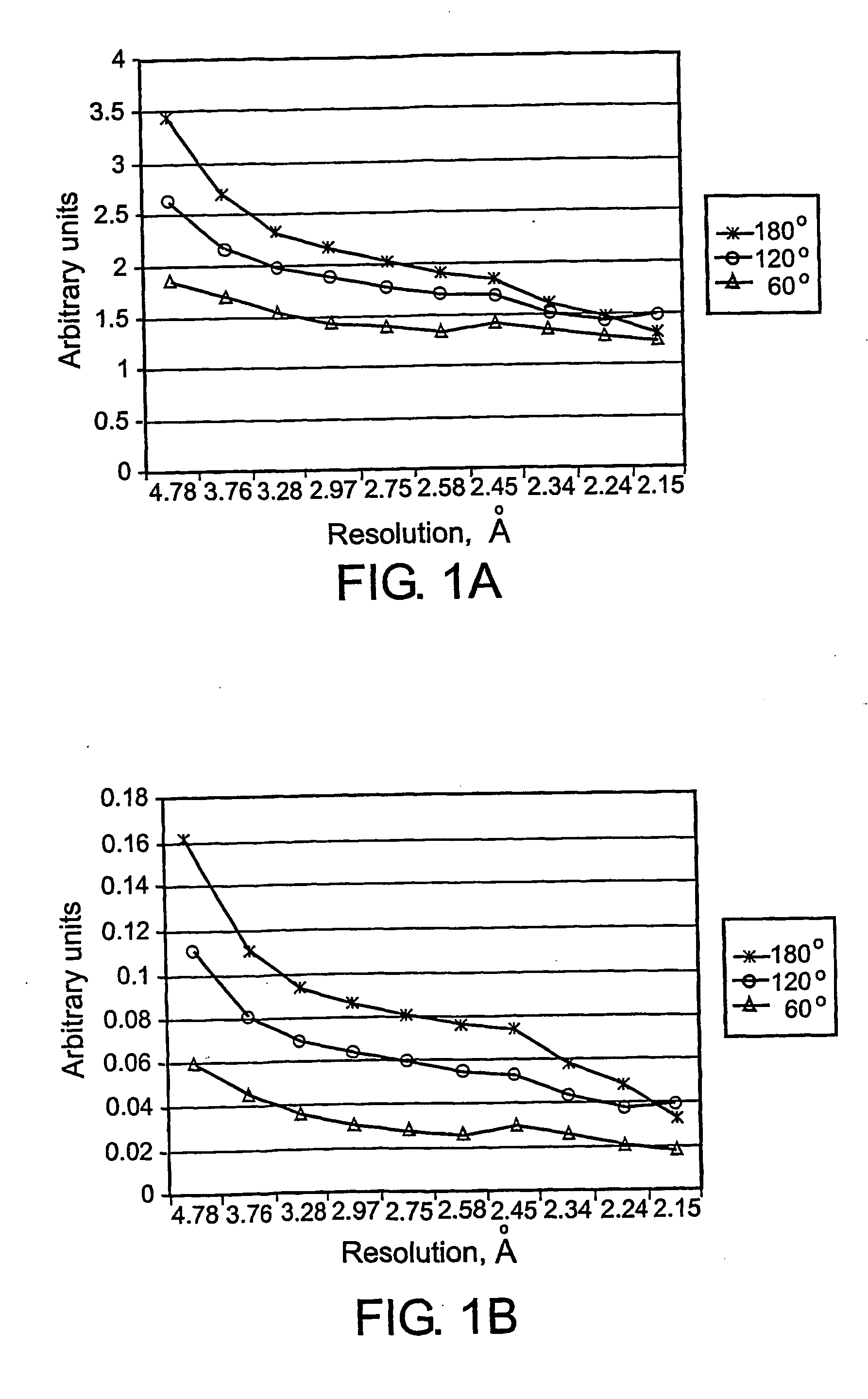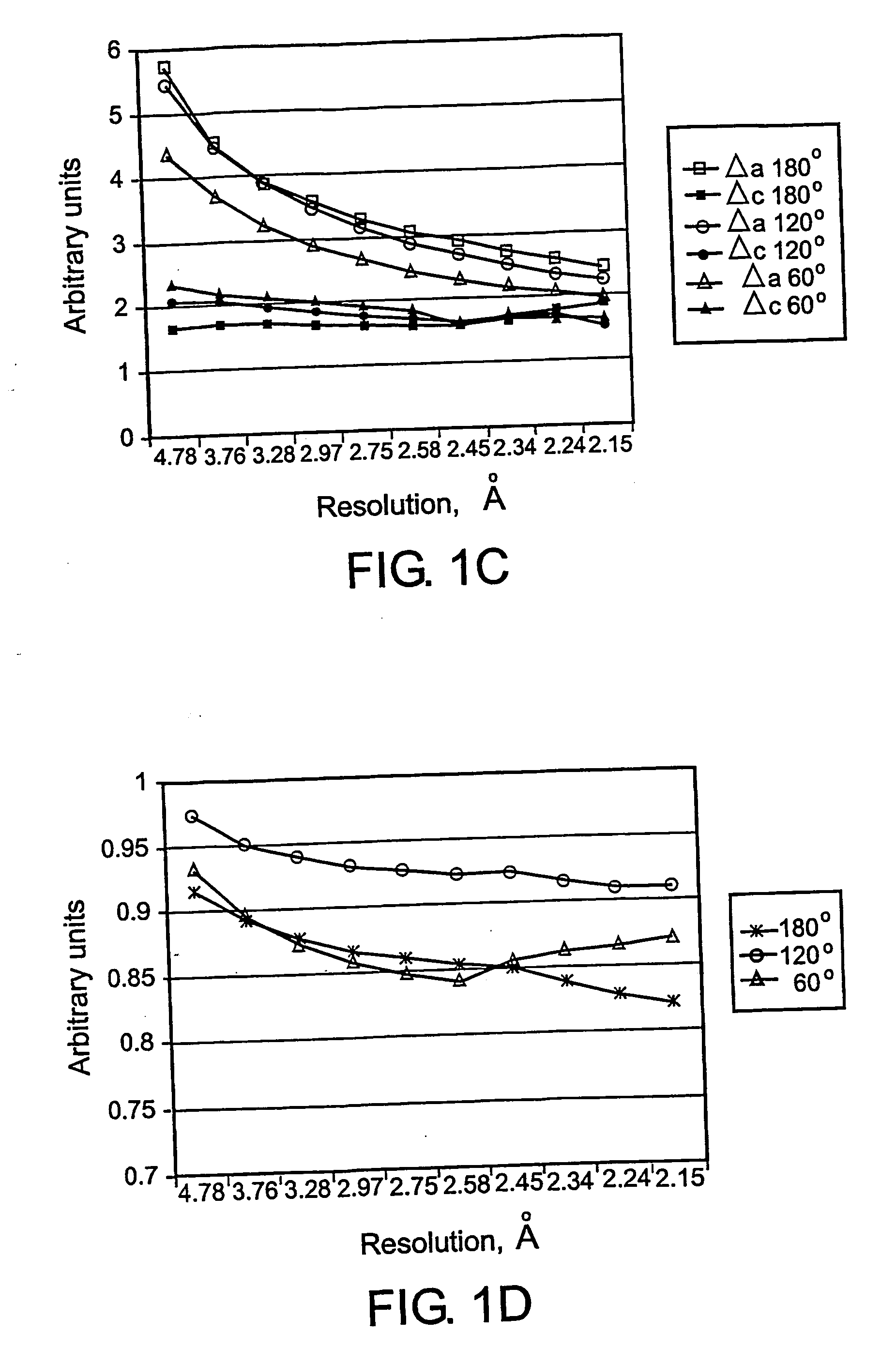[0014] The present invention relates to methods of diffractometrically determining the structures of materials by characterizing their electron density distributions. More particularly, the present invention relates to methods of collecting,
processing and interpreting X-ray diffraction data, which allow real time evaluation of the signal-to-noise ratio in crystal diffraction experiments. The present methods relate to the derivation of statistical indices for monitoring and evaluating signal-to-noise ratios in diffraction experiments. In addition, the present invention provides methods of assessing experimental uncertainty in X-ray diffraction data and in crystal structures derived from experimental data, which are more sensitive than conventional methods. The improved signal-to-noise ratios and
error analysis provided by the present invention result in more reliable and reproducible electron density distributions, which are useful for characterizing the structural and functional properties of crystal samples. The present methods are especially useful for determining electron density distributions and structures for crystals comprised of large molecules, including but not limited to proteins, peptides,
protein-
protein complexes;
protein-lipid complexes; olignucleotides; carbohydrates; lipid-
carbohydrate complexes and
nucleic acid-protein complexes.
[0015] In one aspect, the present invention provides methods of monitoring and statistically evaluating noise levels observed in X-ray diffraction data. In one embodiment, the intensities of diffracted X-ray beams corresponding to symmetry related reflections are measured and compared to each other to provide a real time measurement of random and non-
random noise. The methods of the present invention allow for characterization of an average
noise level corresponding to an entire X-ray diffraction
data set. Alternatively, the methods of the present invention provide a means of characterizing temporal behavior of random and non-
random noise during collection of X-ray diffraction data. Preferred methods of the present invention provide a means of evaluating noise levels corresponding to very short data
collection time intervals. In some applications, the present invention provides a means of analyzing signal-to-noise levels corresponding to data
collection time intervals less than 10 minutes and preferably less than 2 minutes for some applications. Characterization of noise levels corresponding to short time intervals is beneficial because it allows trends in noise as a function of time to be quantitatively evaluated.
Noise levels obtained by the methods of the present invention may be used to provide real time measurements of signal-to-noise ratios observed during an X-ray diffraction experiment. In addition, noise levels measured by the methods of the present invention may be used to correct diffraction signals, particularly anomalous diffraction signals, for the presence of random and non-
random noise.
Noise levels measured by the methods of the present invention also provide information valuable for assessing the quality of a given crystal sample and degradation rates of a crystal due to
exposure to X-rays, changes in temperature or other environmental conditions. Further, noise levels measured by the methods of the present invention also provide information valuable for assessing the performance of an X-ray diffraction
system including methods of evaluating the stability of an X-ray
detector, the uniformity of an X-ray source and / or the stability of a crustal alignment
system.
[0016] In another embodiment of the invention, the present invention includes methods of determining crystal structures using X-ray diffraction data corrected for non-random and random noise. The goal of this aspect of the present invention is to provide methods of increasing signal-to-noise ratios such that more reliable and reproducible electron density distributions are determined. Methods of the present invention using X-ray diffraction data corrected for non-random and random noise levels are beneficial because more accurate electron density distributions may be determined with less
signal averaging and redundancy than in conventional diffractometric methods. A preferred application of this aspect of present invention relates to methods of determining crystal structures using anomalous scattering signals corrected for non-random and random noise. In an exemplary embodiment, the
present method comprises collecting X-ray diffraction data comprising intensities corresponding to a centric reflection pair and an acentric reflection pair. The exemplary method provides for subtracting the intensities of the centric reflection pair to obtain a first intensity difference and subtracting the intensities of the acentric reflection pair to obtain a second intensity difference. In a preferred exemplary embodiment, the first intensity difference is related to the level of noise in the X-ray diffraction data and the second intensity difference is related to the anomalous signal plus the level of noise in the X-ray diffraction data The methods of the present invention further provides for calculating an anomalous scattering signal corrected for noise using the first intensity difference and the second intensity difference and using the anomalous scattering signal corrected for the noise to determine an
electron density distribution for the crystal. In addition, the present methods may further comprising the step of using the anomalous scattering signal corrected for noise to determine an anomalous scattering power of the crystal. As follows from the description of the method, it now becomes possible to monitor the anomalous scattering signal data separated from the noise data in real time as the diffractometric measurements are being taken.
[0019] The present methods of evaluating signal-to-noise ratios during collection of diffraction data are beneficial because they allow important experimental parameters to be assessed in real time during data collection. First, the present methods of evaluating signal-to-noise ratios in real time provide a means of determining how much
signal averaging is necessary to provide X-ray diffraction data capable of generating reliable and reproducible electron density distributions. The ability to quantitatively assess the amount of
signal averaging and redundancy necessary to achieve accurate electron density distributions is beneficial because it maximizes the efficiency f X-ray diffraction data
collection methods and supports applications of high
throughput structure determinations. In addition, the methods of the present invention are able to identify experimental conditions wherein further signal averaging and redundancy does not improve signal-to-noise ratios or actually decreases signal-to-noise ratios. Second, the present methods of evaluating signal-to-noise ratios in real time provide a means of assessing the quality of an irradiated crystal sample. In this context, the quality of an irradiated crystal sample refers to the uniformity of the
crystal structure, uniformity of the physical environment surrounding the crystal, the extent of
crystallinity and / or polycrystallinity of the sample,
structural integrity and mosaicity. Observed trends in signal-to-noise ratio may be related to changes in crystal quality and, therefore, may provide a means of assessing when a change in crystal sample is necessary. In an exemplary embodiment, for example, a new crystal sample is deemed necessary when the observed signal-to-noise ratios fall below a specified threshold value, such as a value of signal-to-noise of 1.67. The value of this threshold may depend on a number of variable include the structure of the crystal, the anomalous scattering power of the crystal and the X-ray diffraction system employed. Third, the present methods of evaluating signal-to-noise ratios in real time provide a means of assessing other experimental parameters important to collecting X-ray diffraction data having high signal-to-noise ratios. For example, decreases in observed signal-to-noise ratio may be used to identify instabilities in the X-ray source, crystal alignment system or X-ray
detector.
[0020] The present invention also provide statistical methods for analyzing a plurality of discrete X-ray diffraction data sets, which improve observed signal-to-noise ratios. In an exemplary method, diffraction patterns are collected in discrete diffraction data sets corresponding to intensity distributions and positions of reflections acquired over different time intervals and / or for different crystal samples. The signal-to-noise ratios of individual diffraction data sets are evaluated using the methods of the present invention. Next, two or more discrete data sets are merged and the signal-to-noise ratios of the combined data sets are determined and compared to the signal-to-noise ratio of the discrete diffraction data sets. In this manner, the signal-to-noise ratio is calculated for all possible combinations of the discrete diffraction data sets. Combinations of data sets are identified wherein the merger of two or more data sets results in an improvement in the observed signal-to-noise ratio. Improvements in signal-to-noise ratio for a merged set may be provided when sources of noise in the data have opposing effects and, hence, cancel each other out. This aspect of the present invention enables the maximum amount of useful information in a diffraction
data set or plurality of data sets to be extracted and utilized in determination of electron density distributions. This aspect of the present invention is applicable to any X-ray diffraction technique where high signal-to-noise ratio is desirable, particularly single
wavelength anomalous scattering techniques, multiple
wavelength anomalous scattering techniques, multiple isomorphous replacement methods and molecular replacement methods.
[0021] The concept of separating an overall
data set into its data subsets and evaluating the statistics of these data subsets individually in order to identify and separate noise and signal levels, as described and claimed therein, opens up the possibility of monitoring the signal and noise levels in any types of data sets containing two or more data subsets in an overall experimental data set. For example, if within the overall data set there are subsets of data of a theoretically equal value, then the data within this type of data set can be used to produce a true measurement of
noise level in the data, since in the real life experiment the theoretical value is never achieved due to experimental and instrumental errors typed of data which are theoretically different can then be used to measure the signal (with noise) level. By comparing the overall magnitudes of these two types of data, one can then monitor the signal-to-noise ratio and determine the usefulness of the data. If there is a signal in the data, but the signal-to-noise ratio is not high enough, one may want to collect additional data to see if the signal-to-noise ratio can be increased when the redundancy in the data set is increased. The ability to directly monitor and statistically evaluate the quality of experimental data during collection is a significant improvement in determining if an experiment is complete or if such an experiment can or cannot produce a successful result. The present invention provides a way to carry out such an evaluation for most types of experimental data. Other types of experiments which can be benefitted by the methods of the present invention include, but are not limited to, the
neutron and
electron diffraction experiments from
crystalline materials and any experiments that have data with the above-described characteristics.
 Login to View More
Login to View More  Login to View More
Login to View More 


